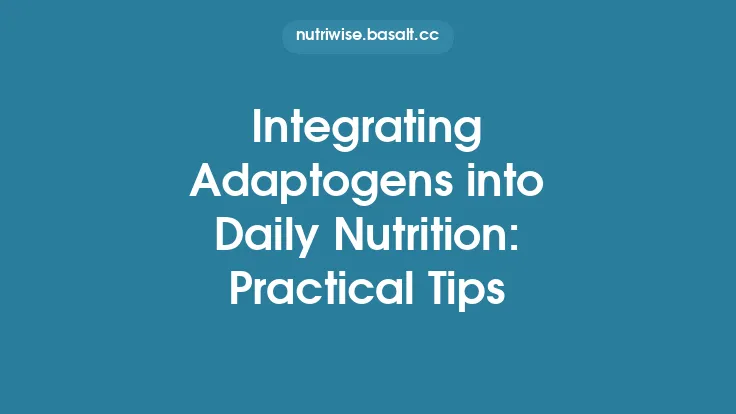Integrating nutrigenomic testing into everyday kitchen routines transforms abstract genetic data into tangible, bite‑size actions. While the science behind nutrigenomics can be complex, the goal of this guide is to translate those insights into concrete practices that fit seamlessly into the home cooking environment. Below you will find a step‑by‑step roadmap that moves from interpreting a test report to organizing pantry shelves, selecting cooking methods, and establishing feedback loops that keep your meals aligned with your genetic profile over the long term.
Understanding Nutrigenomic Test Reports
A nutrigenomic report typically presents three layers of information:
- Gene‑variant identifiers – e.g., *FTO rs9939609, CYP1A2 *–163C>A*, MTHFR C677T*.
- Phenotypic interpretation – a concise description of how the variant may influence nutrient metabolism, taste perception, or enzyme activity.
- Actionable recommendations – suggested dietary adjustments, often expressed as “increase,” “moderate,” or “limit” for specific food groups or nutrients.
When you first receive the report, isolate the actionable recommendations and group them by nutrient class (carbohydrates, fats, proteins, vitamins, minerals). This creates a practical checklist that can be cross‑referenced with the ingredients you already keep on hand.
Tip: Print the recommendation table and keep it on the refrigerator door. A visual cue in the kitchen reinforces the connection between the genetic insight and the next cooking decision.
Translating Genetic Variants into Ingredient Choices
1. Carbohydrate‑Processing Genes
- CYP1A2 (caffeine metabolism) – Fast metabolizers can tolerate higher caffeine without adverse cardiovascular effects, while slow metabolizers may benefit from limiting coffee or tea. In the kitchen, this translates to choosing decaffeinated or low‑caffeine alternatives for the latter group.
- AMY1 copy number (salivary amylase) – Higher copy numbers correlate with more efficient starch breakdown. Those with lower copies may experience post‑prandial glucose spikes after high‑starch meals. Opt for lower‑glycemic starches (e.g., quinoa, steel‑cut oats) and pair them with protein or healthy fats to blunt glucose excursions.
2. Fat‑Metabolism Genes
- APOA2 (fat preference) – Certain variants increase sensitivity to saturated fat, leading to higher post‑meal triglycerides. For these individuals, prioritize monounsaturated and polyunsaturated fats (olive oil, avocado, nuts) and limit butter or lard.
- FADS1/FADS2 (polyunsaturated fatty acid desaturation) – Variants can reduce the conversion of plant‑based ALA to EPA/DHA. Incorporate pre‑formed long‑chain omega‑3s (wild‑caught salmon, sardines) or consider algae‑derived supplements if the kitchen workflow permits.
3. Protein‑Processing Genes
- BCO1 (beta‑carotene conversion) – Reduced conversion efficiency means that dietary beta‑carotene may not meet vitamin A needs. Include pre‑formed retinol sources (liver, fortified dairy) rather than relying solely on orange vegetables.
- SLC30A8 (zinc transport) – Variants affecting zinc handling can influence insulin secretion. Ensure zinc‑rich foods (pumpkin seeds, oysters) are present in meals that contain carbohydrate sources.
By mapping each variant to a specific food group, you can construct a personalized ingredient matrix that guides grocery shopping and pantry stocking.
Cooking Techniques that Honor Genetic Sensitivities
The way food is prepared can amplify or mitigate genetic predispositions. Below are technique‑specific adjustments aligned with common nutrigenomic findings.
| Genetic Sensitivity | Cooking Method | Rationale |
|---|---|---|
| Reduced starch digestion (low AMY1) | Gentle steaming or sous‑vide for whole grains | Lower temperature and longer exposure break down starches gradually, reducing rapid glucose release. |
| Elevated saturated‑fat response (APOA2 variant) | Dry‑roasting or grilling with a thin brush of high‑MUFA oil | Allows excess saturated fat to drip away while preserving flavor from lean protein or vegetables. |
| Impaired omega‑3 conversion (FADS1/2) | Quick sear of fatty fish | Short, high‑heat cooking preserves EPA/DHA integrity, preventing oxidation that can occur with prolonged heating. |
| Caffeine sensitivity (CYP1A2 slow metabolizer) | Cold‑brew with reduced steep time | Extracts less caffeine per volume, delivering a milder stimulant effect. |
| Zinc transport issues (SLC30A8) | Low‑acid sauté of zinc‑rich foods | Acidic environments can chelate zinc; using neutral or slightly alkaline cooking media (e.g., butter, oil) improves bioavailability. |
In practice, maintain a technique log in your kitchen notebook. Record the dish, cooking method, and any observed post‑meal responses (energy, satiety, digestive comfort). Over time, patterns will emerge that fine‑tune your approach.
Managing Portion Sizes and Frequency Based on Metabolic Genes
Genetic variants often influence not just *what you eat but how much and how often*. Implement the following strategies:
- Portion‑controlled containers: Use pre‑measured compartments (e.g., ½ cup for starches, ¼ cup for fats) that align with the recommended intake ranges for your genotype.
- Meal timing windows: For individuals with *CLOCK* gene variants linked to circadian eating patterns, schedule larger meals earlier in the day and lighter meals after sunset.
- Frequency modulation: If a variant suggests heightened insulin response (e.g., certain *TCF7L2* alleles), consider spacing carbohydrate‑rich meals 3–4 hours apart to allow glucose clearance.
These adjustments are best implemented with a simple spreadsheet that tracks daily intake against genetic recommendations, allowing quick visual checks before each cooking session.
Kitchen Organization for Personalized Nutrition
A well‑structured kitchen reduces friction between genetic insight and cooking execution.
- Zoned Pantry
- Starch Zone: Store low‑glycemic grains (farro, barley) alongside portion‑control bins.
- Fat Zone: Keep high‑MUFA oils (extra‑virgin olive oil) front‑facing; store saturated fats (butter) on a higher shelf to discourage overuse.
- Protein Zone: Separate plant‑based proteins (legumes) from animal proteins (lean meats, fish) to simplify pairing decisions.
- Labeling System
- Use color‑coded stickers that correspond to genetic recommendations (e.g., green for “increase,” yellow for “moderate,” red for “limit”).
- Include a brief note on the sticker, such as “Low‑AMY1 – pair with protein” or “FADS2 – add EPA/DHA source.”
- Prep Station
- Install a dedicated cutting board for high‑zinc foods (pumpkin seeds, oysters) to avoid cross‑contamination with high‑phytate items that can inhibit zinc absorption.
- Keep a small batch of pre‑washed, portioned vegetables that align with your carbohydrate recommendations for quick assembly.
By embedding genetic cues into the physical layout, you create an environment where the right choices become the default.
Food Storage and Shelf‑Life Considerations for Genetic Profiles
Nutrient stability can be genotype‑dependent, especially for labile compounds like omega‑3 fatty acids and certain vitamins.
- Omega‑3 Rich Fish: Store in the coldest part of the refrigerator (bottom drawer) and consume within 48 hours of purchase. Freeze extra portions in vacuum‑sealed bags to prevent oxidation.
- Beta‑Carotene Sources: For individuals with reduced BCO1 activity, preserve the carotenoid content by light‑proof storage (opaque containers) and avoid prolonged cooking; quick sauté retains more beta‑carotene.
- Zinc‑Rich Seeds: Keep in airtight containers away from moisture to prevent phytate formation, which can bind zinc and reduce absorption.
A monthly inventory audit helps ensure that nutrient‑dense foods remain fresh and that any compromised items are rotated out before they lose their functional value.
Using Technology and Apps to Bridge Test Data and Cooking
Digital tools can automate the translation of genetic data into kitchen actions.
- Nutrigenomic Integration Platforms: Some services allow you to upload your raw genotype file and generate a shopping list API that syncs with grocery delivery apps.
- Recipe Scalers: Input your portion guidelines, and the app recalculates ingredient quantities while flagging any items that conflict with your genetic limits.
- Smart Kitchen Appliances: Modern sous‑vide devices can be programmed with temperature profiles that align with starch‑digestion recommendations, ensuring consistent outcomes without manual monitoring.
When selecting an app, prioritize those that store data locally or use end‑to‑end encryption, protecting your genetic privacy while still delivering actionable insights.
Monitoring and Adjusting Over Time
Genetic information is static, but its expression can shift with lifestyle changes, age, and health status. Establish a feedback loop:
- Baseline Logging – For the first two weeks, record meals, portion sizes, cooking methods, and any subjective responses (energy, satiety, digestive comfort).
- Periodic Review – Every 3–4 months, compare logs against your genetic recommendations. Look for trends such as persistent post‑meal fatigue, which may signal a need to adjust carbohydrate type or timing.
- Re‑testing – Some nutrigenomic panels offer longitudinal markers (e.g., epigenetic age, metabolite panels) that can be re‑assessed annually to gauge how well your kitchen practices are supporting optimal gene expression.
Documenting these cycles in a digital journal (e.g., a note‑taking app with tagging) makes it easy to retrieve historical data and observe long‑term progress.
Common Pitfalls and How to Avoid Them
| Pitfall | Why It Happens | Practical Fix |
|---|---|---|
| Over‑reliance on single‑gene advice | Many traits are polygenic; focusing on one variant can lead to imbalanced diets. | Use the full report summary; prioritize recommendations that appear across multiple genes. |
| Ignoring food synergy | Nutrient interactions (e.g., fat enhancing carotenoid absorption) are not captured by isolated gene‑variant notes. | Pair fat‑rich foods with carotenoid‑dense vegetables, regardless of individual gene flags. |
| Forgetting lifestyle modifiers | Physical activity, sleep, and stress also affect nutrient metabolism. | Incorporate a brief daily activity log; adjust portion sizes on high‑activity days. |
| Misinterpreting “limit” as “avoid” | “Limit” often means moderate consumption, not elimination. | Set realistic portion caps (e.g., ≤ 30 g of saturated fat per day) rather than removing the food entirely. |
| Neglecting food safety | Some genetic recommendations (e.g., high‑protein intake) may lead to over‑cooking or under‑cooking certain foods. | Follow established food safety guidelines (internal temperatures, storage times) in addition to genetic cues. |
By anticipating these challenges, you can keep your kitchen practices both genetically informed and nutritionally sound.
Looking Ahead: Maintaining Evergreen Relevance
While the core principles outlined here are designed to remain useful regardless of future scientific breakthroughs, staying current is still valuable:
- Subscribe to reputable nutrigenomics newsletters that summarize new peer‑reviewed findings without overwhelming you with jargon.
- Schedule an annual check‑in with a registered dietitian who specializes in genetics; they can help reinterpret your report in light of emerging evidence.
- Refresh your pantry annually, rotating in newer, higher‑quality ingredients that align with any updated recommendations (e.g., newer cultivars of low‑glycemic grains).
By embedding these maintenance habits, your kitchen will continue to serve as a living laboratory where genetic insight meets everyday nourishment—today, tomorrow, and for years to come.





